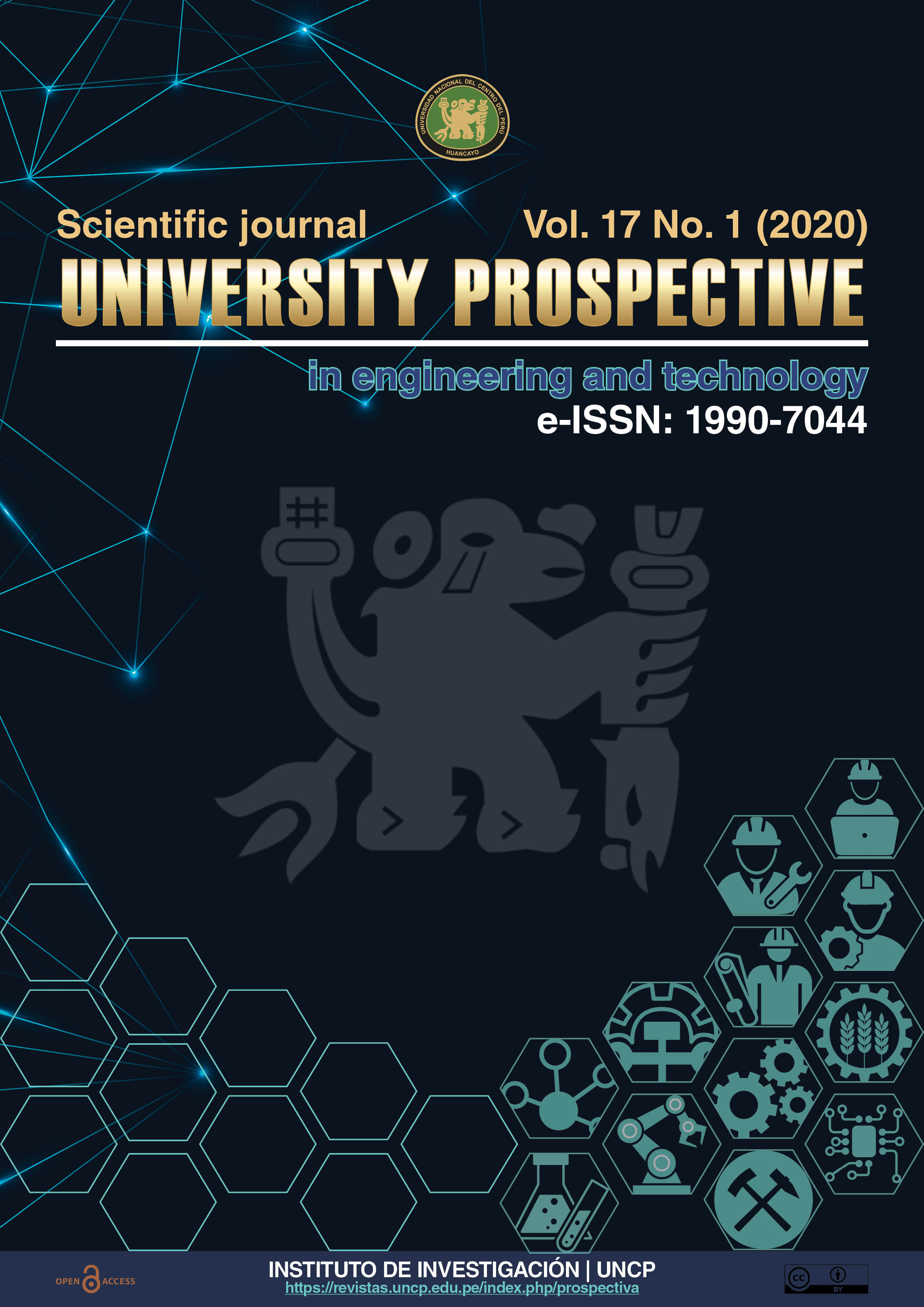Evaluation of the calcination temperature and time in the synthesis and characterization of TiO2 nanoparticles for use as an antibacterial agent
DOI:
https://doi.org/10.26490/uncp.prospectivauniversitaria.2020.17.1384Keywords:
Calcination, TiO2 nanoparticles, Hydrodynamic diameterAbstract
TiO2 nanoparticles in the final treatment of municipal wastewater is of great importance because it is considered a material for the disinfection of total coliforms due to its antibacterial property with respect to its particle size. In the present work, the influence of temperature and calcination time during the synthesis process of titanium oxide nanoparticles has been studied. The results indicate that for calcination temperatures between 300 and 700 °C, TiO2 nanoparticles with hydrodynamic diameters ranging from 12 to 60 nm are obtained, which were found with a calcination time of 1 hour and 30 minutes. These results would indicate that for TiO2 nanoparticle sizes smaller than 60 nm, a decrease in the bacterial population present in treated municipal wastewater would be achieved, thus facilitating the reuse of this water through the application of a new technology.
Downloads
References
Andrea, M., Urbano, V., Fernández, Y. O., Mosquera, P., Enrique, J., & Páez, R. (2011). Nanopartículas de TiO2, fase anatasa, sintetizadas por métodos químicos. Revista Científica Ingeniería y Desarrollo, 29(2), 186-201–201.
Buraso, W., Lachom, V., Siriya, P., & Laokul, P. (2018). Synthesis of TiO2 nanoparticles via a simple precipitation method and photocatalytic performance. Materials Research Express, 5(11), 0–10. https://doi.org/10.1088/2053-1591/aadbf0
Enríquez, J. M. H., Serrano, L. A. G., Soares, B. H. Z., Alamilla, R. G., Resendiz, B. B. Z., & Sánchez, T. D. A. (2008). Síntesis y Caracterización de Nanopartículas de N-TiO2 - Anatasa. Superficies y Vacío, 21(4), 1–5.
Gartiser, S., Flach, F., Nickel, C., Stintz, M., Damme, S., Schaeffer, A., Erdinger, L., & Kuhlbusch, T. A. J. (2014). Behavior of nanoscale titanium dioxide in laboratory wastewater treatment plants according to OECD 303 A. Chemosphere, 104, 197–204. https://doi.org/10.1016/j.chemosphere.2013.11.015
Kim, M. G., Kang, J. M., Lee, J. E., Kim, K. S., Kim, K. H., Cho, M., & Lee, S. G. (2021). Effects of Calcination Temperature on the Phase Composition, Photocatalytic Degradation, and Virucidal Activities of TiO2Nanoparticles. ACS Omega, 6(16), 10668–10678. https://doi.org/10.1021/acsomega.1c00043
Leyva-Porras, C., Toxqui-Teran, A., Vega-Becerra, O., Miki-Yoshida, M., Rojas-Villalobos, M., García-Guaderrama, M., & Aguilar-Martínez, J. A. (2015). Low-temperature synthesis and characterization of anatase TiO2 nanoparticles by an acid assisted sol-gel method. Journal of Alloys and Compounds, 647, 627–636. https://doi.org/10.1016/j.jallcom.2015.06.041
Lusvardi, G., Barani, C., Giubertoni, F., & Paganelli, G. (2017). Synthesis and characterization of TiO2 nanoparticles for the reduction of water pollutants. Materials, 10(10), 1–11. https://doi.org/10.3390/ma10101208
Mosquera, E., Rosas, N., Debut, A., & Guerrero, V. H. (2015). sintesis y caracterizacion de nanoparticulas de Dioxido de Titanio obtenidas por el metodo sol-gel. Revista Politécnica, 36(3), 7. https://revistapolitecnica.epn.edu.ec/ojs2/index.php/revista_politecnica2/article/view/525
Shah, A. H., & Rather, M. A. (2021). Effect of calcination temperature on the crystallite size, particle size and zeta potential of TiO2nanoparticles synthesized via polyol-mediated method. Materials Today: Proceedings, 44(xxxx), 482–488. https://doi.org/10.1016/j.matpr.2020.10.199
Wetchakun, N., Incessungvorn, B., Wetchakun, K., & Phanichphant, S. (2012). Influence of calcination temperature on anatase to rutile phase transformation in TiO 2 nanoparticles synthesized by the modified sol-gel method. Materials Letters, 82, 195–198. https://doi.org/10.1016/j.matlet.2012.05.092
Downloads
Published
Issue
Section
License
Copyright (c) 2020 Ingaruca Alvarez, Ever Florencio

This work is licensed under a Creative Commons Attribution-NonCommercial-ShareAlike 4.0 International License.
Esta Revista es de acceso abierto a su contenido a través del Internet, poniendo a disposición de la comunidad científica los resultados de la investigación, de manera gratuita, para el intercambio del conocimiento desarrollado.
El contenidos de la Revista se distribuyen bajo la licencia Creative Commons Reconocimiento-NoComercial-CompartirIgual 4.0 Internacional.
![IconJournalPU [ENG] by Edgar Julian-Laime®](https://revistas.uncp.edu.pe/public/journals/1/pageHeaderLogoImage_en.png)









